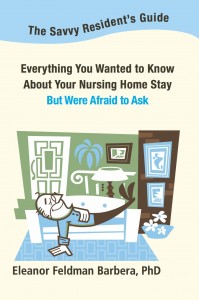Category: Communication
Posted by Dr. El - June 8, 2016 - Communication, Customer service, End of life, McKnight's Long-Term Care News, Resident care

Here’s my latest article on McKnight’s Long-Term Care News:

![]()
Assistance in creating a “good death” is a fundamental task of any organization working with elders and may be addressed by a number of team members singly or in combination. Since these discussions are often easier said than done, I thought it might be helpful to share some of my experiences since I, as a geropsychologist, regularly discuss dying with residents and their families.
It’s a more-than-timely topic. As I once wrote in my column, “Creating better deaths in long-term care,” end of life care has been the subject of increased media attention in recent years. The importance of a conversation or series of conversations about the resident’s wishes has been emphasized by organizations like The Conversation Project and writers such as Atul Gawande, M.D. in his bestselling book, “Being Mortal.”
Here’s some added perspective. Not too long ago, I was checking the medical orders in a long-term resident’s chart when I noticed that she was “full code.” Bernice was 92 years old with a history of chronic illnesses and a recent decline in functioning.
While many residents have advance directives that prohibit care in the event that breathing or the heart stops (such as a Do Not Resuscitate order), full code allows for all interventions needed to restore breathing or heart functioning, including chest compressions, a defibrillator and a breathing tube.
I thought of the distraught expressions on the faces of the nurses who had rushed to provide full code care to Jim, a frail elderly man who’d been a staff favorite during the course of his stay. The full code was at the insistence of his son, who couldn’t bear the thought of his dad’s passing. Jim’s ribs were cracked, the effort was unsuccessful and the nurses were devastated – at having to perform the procedure, not because Jim had died. It was obvious to everybody in the nursing home that Jim had been dying for months despite his son’s desire to forestall the inevitable.
Mindful of Jim’s painful demise, I raised the issue of advance directives with Bernice, asking her if she knew what “full code” meant and if she’d given any thought to how much medical treatment she wanted at the end of her life.
“What will be, will be,” she told me. “I don’t want to talk about it.” Her tone made it clear that persistence would be futile.
“There’s a lot more to it than that,” I replied, “but we don’t have to talk about it today.” I made a mental note to pursue the topic when she seemed less inclined to throw me out of her room.
For the entire article, visit:

Posted by Dr. El - April 5, 2016 - Communication, End of life, Engaging with families


Aging advocate Carol Marak interviewed a group of eldercare experts (including me) regarding their experiences discussing death and dying with elders and their families. Her Huffington Post piece on the topic, excerpted below, suggests that yes, families — and many healthcare providers — are ready to have these important and necessary conversations.
Most people avoid the topics of aging and dying like the plague, don’t you agree? Erica Hollack, the author of “Live Well, Die Well,” doesn’t think so and argues the opposite. She attended a conference on end-of-life concerns and discovered that the 800 chairs set up for the workshop were not enough. The community came out in droves to hear the meaningful conversation in Spokane. So, as a whole, our culture may not be averse to talking about the end of life.
The Institute of Medicine (IOM) believes the time is right for a national dialogue to normalize the emotions on death and dying. They think that the social trends point toward a growing willingness to share stories about the end-of-life care and that it will help drive more family discussions. In the IOM consensus report, Dying in America, experts found that accessibility of medical and social services could improve a patient’s life at the end. But if people don’t discuss which medical care or social services they want or not, how will their wishes be known and carried out?
Since 70 percent of ill adults become unable to express their care preferences, the separation between what they want, and what they receive is significant and usually is the result of misinformation. Having end of life discussions can put a stop to the discrepancy. IOM believes we can do this through public education and engagement.
My family experienced several deaths over the years. However, one, in particular, sticks out. It was my brother-in-law’s. The medical and hospital staff followed his values, goals, and educated preferences. It made the process for everyone more relaxed and comfortable. The best of all, it created the sacred space for good-byes, forgiveness, and regrets. To this day, the family remains in awe of that unprecedented event.
There is power in stories. And by sharing them, it’s my hope to encourage meaningful dialogue between individuals and their families about beliefs, care, and choices. By sharing personal events and accounts, fear will dissipate. Death is a process to appreciate, and family members should spend the time reminiscing not deliberating over medical treatments.
The Institute of Medicine also recommends that service providers stimulate advance care planning between clients and medical teams so that the individuals can make informed choices based on one’s needs and to make them known. To unlock the narratives of death and dying so that others become more comfortable with the topic, I asked the Seniorcare.com Aging Council,
“Share one example of a family or person/client who experienced a higher quality of care as a result of having an open talk with loved ones?”
For the entire article, visit:
Posted by Dr. El - March 1, 2016 - Business Strategies, Communication, McKnight's Long-Term Care News

Here’s my latest article on McKnight’s Long-Term Care News:

Last week I was speaking about the needs of younger residents at the North Carolina Health Care Facilities Association convention and had the opportunity to hear a presentation by David Gifford, MD, MPH, Senior Vice President of Quality and Regulatory Affairs of the American Health Care Association (AHCA). He was discussing what providers could expect from upcoming AHCA quality initiatives. I was listening with a clinician’s ears and, aside from feeling grateful that I’m a clinician and not an administrator, several points stood out for me.
• Turnover is going to be added to the 5-Star Rating System. Better-rated facilities will be expected to have a turnover rate of 40% or less. He didn’t specify how to accomplish this, but my article, “Keys to reducing turnover in LTC,” offers many suggestions to address the problem. As I noted in the column, a 2007 Donoghue and Castle study found that “increasing the number of aides per resident from 33 per 100 to 41 per 100 reduced CNA turnover from 65% to 41% and also lowered LPN and RN turnover.” Taking that action alone could bring your facility to the sought-after turnover rate.
• Analyze problems with the right attitude. When doing a root-cause analysis of challenges such as falls, infections, pressure ulcers, etc., Gifford recommends operating from the assumption that “everything is preventable” rather than a defeatist whaddayagonnado stance. (OK, I’m paraphrasing that last part.) In his experience, this attitude makes a big difference in finding areas of potential change.
He also points out that difficulties frequently stem from a systems problem or lack of skill rather than a knowledge deficit on the part of staff. Rather than providing knowledge-focused in-service trainings in an attempt to rectify situations, ask staff members what “frustrates” them about a particular problem and whether they have suggestions about how to remedy it.
• Use pilot studies. When making needed modifications, start with a very small sample rather than immediately making a facility-wide adjustment of systems. Follow the model of “one staff member, one resident, one day.” This trial run provides the opportunity to see how the new system works and creates staff buy-in before committing the entire facility to the changes. Staff buy-in is enhanced if the selected staff member is someone respected by peers.
For the entire article, visit:

Posted by Dr. El - February 16, 2016 - Business Strategies, Communication, Customer service, McKnight's Long-Term Care News, Resident care, Technology

Here’s my latest article on McKnight’s Long-Term Care News:

In “A potential lawsuit in every worker’s pockets?”, McKnight’s Editorial Director John O’Connor describes two of many recent incidents of long-term care workers using their cell phones to record residents in embarrassing situations and post the photo or video to social media.
Despite leading to termination of employment and lawsuits, some of the employees involved appear to have no idea that this behavior is a serious ethical breach. Staff writer Emily Mongan offers the following quote in her article on this topic: “They just blew everything out of proportion,” [the offending employee] said. “It was just a picture of her butt.”
Wondering how an employee could possibly think posting a photo of a resident’s behind to social media would be a reasonable action to take, I contacted psychologist and social media expert Keely Kolmes, PsyD , to find out.
Changing expectations of privacy
Dr. Kolmes notes that it’s become commonplace for people to record moments from their lives and post them to social media, generally without consent from others who might be captured in the photos or videos that are shared.
For example, while I get my daughter’s permission before I post anything about her to my private Facebook page, I occasionally find her featured in photos with friends on their pages without prior approval. Posting friendly pictures is considered acceptable in one’s personal life (and a parent who asks permission from their child is, I suspect, unusual).
One might argue that there’s a distinction between personal and professional situations, yet similar situations frequently occur in professional settings as well, such as discovering you’ve been featured in a photo on the website of an organization after attending their conference or on your facility website after the holiday party.
Most people are pleased to be highlighted in such photos, but if an organization expects employees to follow their social media policy, these situations are a prime opportunity to show workers that the policy is being followed at the corporate level as well. At facility events, for instance, notify staff members that photos will be taken and may be posted.
Resident/staff boundaries: Whose life/home is it?
For the entire article, visit:

Posted by Dr. El - January 6, 2016 - Business Strategies, Communication, For Staff, McKnight's Long-Term Care News, Motivating staff, Psychology Research Translated, Something Good About Nursing Homes

Here’s my latest article on McKnight’s Long-Term Care News:

Woohoo! My first column of 2016.
Which was started during a bout of insomnia in the last week of 2015.
What did I do when sleep failed me? What electronics-addicted individuals often do in the middle of the night. I grabbed my computer, caught up on email, and headed over to Facebook to find out what my Friends had been up to.
There I discovered a post about a company founded by two brothers called Life is Good, which emerged from the standing request the founders’ mother had for them as children in a chaotic home environment: Tell me something good about your day.
This helped the brothers become “glass half full” kind of guys, the type of people who donate 10% of their profits to help children overcome adverse childhood experiences.
And what does a T-shirt company have to do with long-term care? Well…
What if we started off this brand new year asking ourselves and our coworkers, employees and residents to tell us something good?
What if we put time and thought into focusing on the positive — into growing the good — and reminding ourselves why we’re all here working with elders?
I predict we’ll have more productive staff, better functioning teams, and happier residents.
It’s not just me doing the predicting. The Positive Psychology Center, led by director Martin Seligman, Ph.D., describes positive psychology as “the scientific study of the strengths that enable individuals and communities to thrive.”
For the entire article, visit:

Posted by Dr. El - November 20, 2015 - Communication, Engaging with families, For Families, Tips for gifts, visits, Videos

With the start of the holiday season, it’s time for this perennial post from Dr. El:

‘Twas the Week Before Christmas…
And 83-year old Albertha assured me her family was planning to take her home for the holidays.
“Have you talked to them about it? Have they called the social worker to arrange a pass, and meds, and transportation?”
“No,” she replied, “but they’re coming to get me.”
‘Twas the week after Christmas, and Albertha was glum.
“They didn’t show up. I waited all day, but they didn’t come.”
Albertha spent Christmas day watching other people go out on pass and return, and seeing families arriving with food and gifts and smiles.
Now my residents and I start discussing the holidays a few weeks in advance, addressing wishes and practicalities, phoning families if needed, and getting the social worker involved. We set up a hierarchy of plans.
Plan A: Go home for the day.
Plan B: Go out to a wheelchair accessible restaurant with family.
Plan C: Have visitors come with food and go around the corner for coffee, if possible, just to get out.
Plan D: Stay in with visitors and food.
Plan E: Talk to family members on the telephone, discussing plans for a future visit, while sitting in a room festooned with cards and holiday decorations. Attend the nursing home holiday party.
Plan F: Have a small holiday gathering in the room with nursing home friends after the facility party.
Since then, my people know what to expect from the holidays, even if the expectation is that their family might not arrive as hoped.
Three tips from Dr. El for the holidays (click here or view below): http://youtu.be/8HTjVoKQmKo

MyBetterNursingHome.com
Posted by Dr. El - October 8, 2015 - Communication, Customer service, Resident care

New York Times writer Jane Brody recently penned two excellent columns on the value of hearing aids and the obstacles to obtaining them. (The links to these articles are below.) The articles led me to reflect on my experience with hearing aids as a psychologist in long-term care. I’ve noticed additional obstacles to hearing aid use:
- The aids are in the dresser drawer rather than the ears of the residents who need them.
- The hearing device is locked in the nursing cart or closet.
- The batteries are no longer functioning and there are no backup batteries.
Here are some suggestions to remedy these challenges:
- Nurses, aides, ombudsmen, readers: Please consider putting in hearing aids as essential a part of getting ready for the day as putting on a shirt.
- Establish a convenient location for all assistive devices so that eyeglasses, hearing aids, and dentures are easy to find and store. A special caddy for a dresser drawer would be very helpful in keeping track of these important items.
- Keep backup batteries available so that dead batteries don’t mean several weeks of isolation. Sell batteries on an Independence Cart, or traveling store.
As Jane Brody points out in her articles, losing the ability to hear can lead to social isolation, cognitive impairment, excessive fatigue and other maladies. Let’s do what we can to keep our residents at their best.

Posted by Dr. El - September 30, 2015 - Business Strategies, Common Nursing Home Problems and How Psychologists Can Solve Them, Communication, McKnight's Long-Term Care News, Medication issues, Motivating staff, Psychology Research Translated, Role of psychologists, Something Good About Nursing Homes

Here’s my latest article on McKnight’s Long-Term Care News:

Antipsychotic medications have proved ineffective at reducing the symptoms associated with dementia. They also have serious side effects in older adults, including restlessness, dizziness, higher likelihood of falls and other problems that can contribute to an increased risk of death.
Behavioral health interventions, on the other hand, have no such side effects and have been found effective in reducing behaviors such as aggression, care refusal and wandering.
Employing behavioral health techniques with people with dementia becomes increasingly valuable as facilities in this country endeavor to follow the Centers for Medicare & Medicaid Services guidelines and reduce the use of antipsychotic medications.
Global efforts
Dementia care is a pressing issue around the world, and other countries have made headway in shifting from medication to behavioral interventions. Psychologist Paula E. Hartman-Stein, Ph.D., of The Center for Healthy Aging, writes about international programs that implement behavioral health methods in the September/October edition of The National Psychologist.
Dr. Hartman-Stein spoke with Cameron Camp, Ph.D., an expert who consults with long-term care facilities in the United States and abroad.
France
Dr. Camp reports that the French government pays nursing homes to train their staff in non-pharmacological approaches to dementia. The training includes various strategies, including Montessori techniques such as those described by Dr. Camp in his excellent book, “Hiding the Stranger in the Mirror,” and other publications.
Australia
Camp notes that Alzheimer’s Australia provides funding to train staff in behavioral health approaches. Its website, Alzheimer’s Australia Information for Health Professionals, offers helpful information and brief videos that explain the techniques used.
Canada
In Canada, the Canadian Foundation for Healthcare Improvement reports on the success “beyond the team’s expectations” of an effort to reduce antipsychotic medications and implement non-pharmacological approaches. The project saved $400,000 in six months across the Winnipeg region.
STAR-VA in the USA
Here in the United States, the Veterans Health Administration, less constrained by the fee-for-service psychotherapy model that plagues the rest of the country, utilizes staff psychologists and other behavioral health professionals in their Staff Training in Assisted Living Residences (STAR-VA) model.
For the entire article, visit:

Posted by Dr. El - September 15, 2015 - Business Strategies, Communication, Customer service, Engaging with families, McKnight's Long-Term Care News, Resident/Family councils

Here’s my latest article on McKnight’s Long-Term Care News:

When families seek mental health treatment, it’s often because of a “problem child.” Family therapists consider this person to be the “identified patient” and recognize that the troubled individual is part of a family unit whose members all benefit from assistance.
By contrast, when a resident enters long-term care, we tend to focus solely on the needs of the resident, even though they’re almost always part of a family system that is being affected by their placement.
Oddly, we do this in spite of the fact that it’s frequently a family member who chooses the facility or community where the loved one will live.
If we consider that we’re admitting families rather than just the residents themselves, we’d recognize the need to provide family-centered care in addition to resident-centered care.
Instead, we repeatedly attend to the needs of families in a haphazard, reactive fashion. Those tense family meetings with the director of nursing and the administrator after the staff “mishandled” an interaction with a family member are more likely a lack of organizational attention to the needs of families and an absence of proper training than they are a reflection of staff error or of a “difficult” family.
Here are some ways to implement family-centered care:
1. Convey essential information to families about your facility or campus in a way that’s easy to access. If your website offers only platitudes about how you really care and then lists insurance options, you’re telling potential customers what you really care about and it isn’t them. Instead, turn your site into a 24/7 support kiosk, answering questions families commonly have about your community and helping them to be better caregivers and community members. Include, for example, information about their role in care plan meetings or how to help their loved one adjust to their new home. Add a list of resources they might want to consult. (My book, “The Savvy Resident’s Guide,” for example, is one way to offer information and soothe the frayed nerves of family members.)
2. Hold regular family meetings on topics that frequently affect them, such as caregiver stress, understanding dementia, and making the most of an off-campus pass (a great session to hold before the holiday season, hint, hint). Even though this may seem like yet another task to add to an already burdened staff, it will save time in the long run: Rather than answer the same questions individually, your staff can direct families to the meetings where questions can be discussed simultaneously and in depth.
3. Reach out to families during transitions in care, such as moving from an independent apartment to the care center in a continuing care retirement community.
For the entire article, visit:

Posted by Dr. El - September 10, 2015 - Communication, McKnight's Long-Term Care News, Talks/Radio shows

Over 1000 listeners attended my McKnight’s Fall Online Expo webinar, “Letting them go with style,” which focused on ways to use the loss of employees to strengthen your organization. McKnight’s editor Jim Berklan moderated the event and shared his thoughts about the webinar in his Daily Editor’s Notes column today. I’m gratified to hear that the talk helped participants consider aspects of staff departures in a way they hadn’t previously considered. (Thank you, Jim, for your kind review!)
You can hear the replay of the webinar (archived for a year) at: Expo Registration
It’s fairly likely that one or more of your employees will be leaving soon. That’s why you need to read this. It will make your organization healthier, and in ways you might have never imagined.
The goodbye guru would have it no other way.
I typed that name generically — with lowercase g’s — but I just as easily could have written Goodbye Guru. Then I would be referring to a specific person, namely Eleanor Feldman Barbera, Ph.D.
You might know her better as “Dr. El,” as in “The World According to Dr. El,” the award-winning blog that appears twice monthly on this website.
Regardless, she is an eloquent font of knowledge about what makes humans tick, and tock. Wednesday, we had a unique opportunity to hear her address a slightly off-kilter question: How should providers deal with an employee’s departure to create the best circumstances for their long-term care community?
I say “off-kilter” because the most common inference about a webinar named “Letting them go with style” would be that it’s about dying residents. Instead, Barbera fascinated listeners at McKnight’s Fall Online Expo with approaches and implications for dealing with departing employees.
Whether by firing, lay-off, resignation or for other reasons, employees leave long-term care operators often. And the emotional and psychological well-being of whoever remains is typically the worse for it — and usually to an unnecessary degree — Barbera pointed out.
It doesn’t have to be that way. She urged everyone to consider the multiple layers of messages any departure makes. This could mean saddened and suddenly insecure residents (“Who will take care of me?” “Didn’t she like me enough to say goodbye?”) to unnerved or perturbed staff members, to disgruntled or dangerous former employees.
All of which make for an unstable environment. Thus, more care should be taken with departing employees, Barbera emphasized. She illustrated numerous scenarios involving employee terminations, pointing out how providers can handle them better.
For the rest of Jim Berklan’s article, visit:
























